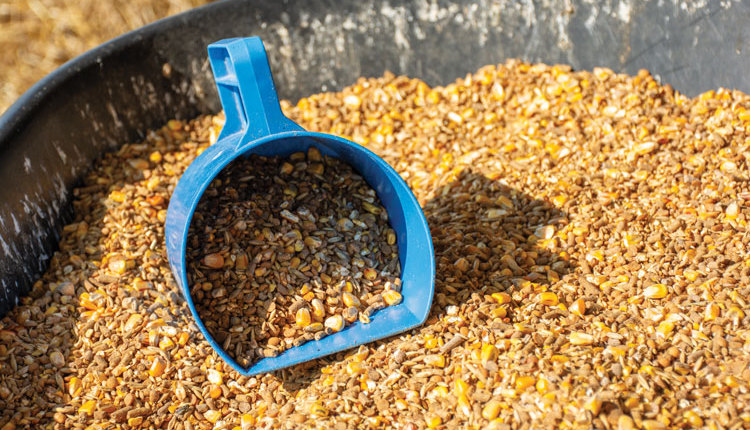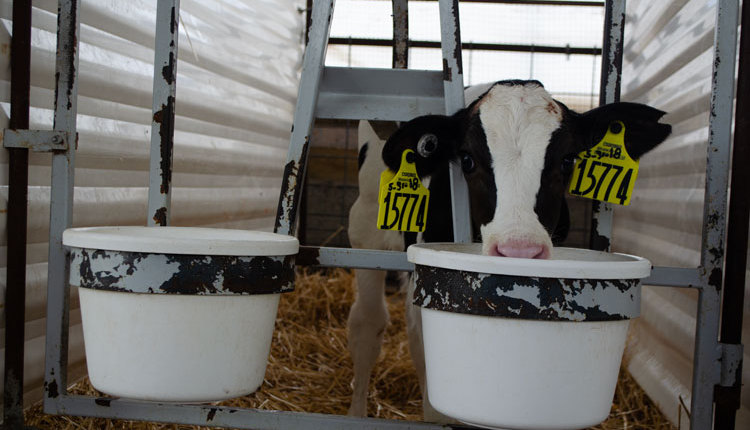
Its demise began in the 1980s; before, most calf starter had been texturized. At that time, a major feed supplier in the northeast United States made and marketed a pelleted calf starter. This phenomenon resulted in calves chewing available wood such as in feed mangers, fence posts, or walls. Calves began to chew because no significant particle size was available in the pelleted starter.
Larger particles available in texturized calf starter allows calves to chew to reduce particle size, which also causes salivation. When these contents are reswallowed, the saliva buffers the rumen to keep it from becoming more acidic.
A different era
In the 1980s, calves were still viewed mainly as a cost factor in a dairy operation — keeping the early weaning program in vogue. This resulted in a lower protein diet, the traditional daily 1 pound of the 20% protein and 20% fat milk replacer. Cost was the driving factor in all of these situations, including feeding pelleted versus texturized starter.
In 2007, I had an aha moment when visiting a large dairy in another country. The dairy was feeding an all-pelleted calf starter, and I noticed almost no calves ruminating. When I came back to the U.S., I contacted John Porter of the University of New Hampshire Extension. Porter had completed his master’s degree at Cornell University while I was obtaining my Ph.D. He was working with Dick Warner, whose studies in the 1950s and 1960s focused on the type of rumen fermentation volatile fatty acids formed in a calf that led to its functional ruminal development. This heretical finding was difficult to accept — even by some today. Porter fed a starter that was either all pelleted or all texturized. The texturized starter boosted intake and daily gain, reduced age of rumination, added to the percent of time spent ruminating, raised rumen pH, lengthened papillae, and improved fiber digestibility.
Yet a nagging issue about feeding calves was the cost. About 15 years ago while visiting with Mike Van Amburgh at Cornell University, I was astonished to find that he had been collecting calf data for over 10 years at their research dairy. I encouraged him to publish this data. Later, he teamed up with geneticist Bob Everett and graduate student Fernando Soberon to find that for every additional pound of daily gain, heifers produced 850 pounds more milk during their first lactation and 2,280 more pounds for their combined first three lactations. This data showcased that calves were not just a cost but an investment that paid off in lactation performance.
Milk replacer matters
In another Penn State analysis of nine published studies with 21 treatments, there was an inverse relationship in which each additional 100 grams of dry matter milk replacer intake resulted in a 60-gram starter intake decline. Thus, the greater amount of liquid fed, the less starter was consumed.
Mark Hill and colleagues at the Provimi research group found that calves weaned after 49 days had a 0.11-pound drop in daily gain, consumed 0.53 pounds less starter, and had a 12% lower feed efficiency as 2.3 pounds of milk replacer was fed daily prior to weaning versus 1.28 pounds. Digestibility of dry matter, starch, neutral detergent fiber (NDF), and acid detergent fiber (ADF) were also lower postweaning as more milk replacer was fed. A similar study found that when calves were fed 1, 1.67, and 1.96 pounds of milk replacer daily, digestible dry matter, NDF, and ADF intakes were lower at 11 weeks for the calves fed higher volumes of milk replacer. In both studies, the same texturized starter containing 37% whole corn kernels, 25% whole oats, 35% of a pelleted premix, and 3% molasses was fed.
Pay attention to ingredients
So, what’s happening? Inadequate starter intake prior to weaning negatively affects functional rumen development prior to and after weaning. In a systematic review and meta-analysis published in the American Registry of Professional Animal Scientists Journal, lead author Morteza Ghaffari and I found that starter termed “texturized” contained less than 30% to over 60% grain with a minimum level of 45% being recommended.
Providing hay, which results in gut fill, can confound results when low amounts of starter are eaten. A Canadian study illustrated this when calves were fed a texturized starter alone or with alfalfa hay. The starter contained 14% flatted barley, 13% flatted oats, and 10% steamed corn, resulting in only 37% texture.
The low rumen pH of 5.06 clearly showed that the treatment using the starter alone was not adequately texturized. There was no difference in body weight between the two treatments, and true body weight was distorted by 10.3 pounds more gut fill (0.7 pounds of which could also have been from the increased tissue weight) on the starter fed along with hay treatment. This gut fill may not be visually evident. Thus, calf trials in which hay is also fed should have gut fill measurements to avoid confounding growth data.
In a 2018 National Animal Health Monitoring System (NAHMS) study, Holstein calves averaged 1.6 pounds daily gain prior to weaning, but that was reduced to 1.3 pounds postweaning. This is indicative of two things. First, preweaned daily gain was good and would approximately double birth weight at 2 months of age — the gold standard recommendation by the Dairy Calf and Heifer Association. But then there was a slump in weight gain in the month after weaning. I would submit that this is most likely due to inadequate starter intake prior to weaning, resulting in poor functional rumen development as found by Mark Hill and colleagues. Unfortunately, few calf studies measure postweaned performance. Too many calf studies do not even characterize the starter fed, when that can confound data and even predetermine the results. Researchers need to understand these aspects and measure postweaning performance and the impact of calf starter physical form on their study results.
Chop length
The main reason I hear why dairy operations do not feed texturized starter is cost. Let’s say at worst it costs $25 more per calf in the first 3 months of life to feed texturized starter versus an all-pelleted starter. If you feed a pelleted starter, you should feed forage at a lower level, say 5%, and it should be chopped to better facilitate calf intake. This means you will need to source forage such as straw or hay at the correct chop length. Chopping alfalfa hay can cause loss of leaves which contain most of the protein and calcium. A recently published calf study used chopped alfalfa hay that only contained 12.3% protein. Now you have another ingredient to organize, store, and quality control, which uses more labor. What does all of that cost?
So, while we rightly have paid more attention to the liquid feeding program, we have regressed on the starter side to replacing a well-texturized starter with an all-pelleted or ground starter without measuring or understanding the costs and consequences. Assessing how the type of starter fed affects calf performance can aid in calf management.
250410_161











